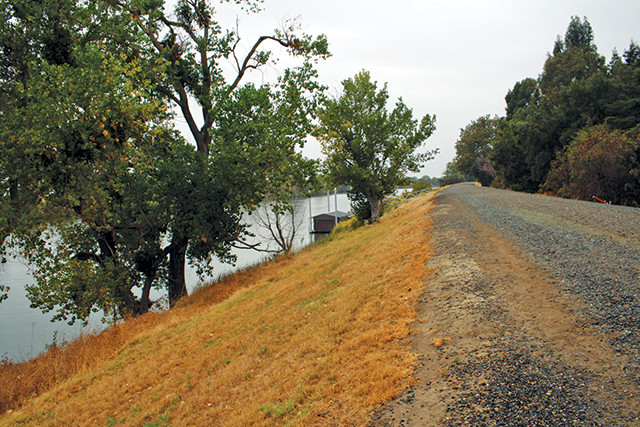
by Terri Cook Tuesday, March 15, 2016

An earthen levee along the Sacramento River in California. Credit: public domain.
Levee failures are most often associated with the onslaught of water from large storms, such as Hurricane Katrina, whose landfall in 2005 caused more than 50 floodwalls and levees around New Orleans to fail.
But the lack of water can also weaken these critical earthen structures, according to recent research presented last December at the fall meeting of the American Geophysical Union in San Francisco. Such weakening is of particular concern in California, which, despite several El Niño-related storms, is still experiencing its fourth consecutive year of drought, says Joe D. Robinson, an engineer at Terracon Consulting Engineers and Scientists, who conducted the research while a graduate student at Mississippi State University. “Drought risk and the potential implications of the future climate were not considered during the construction of California’s levee systems,” Robinson says.
Using a regional-scale analytical model, Robinson and his co-authors studied the effects of drought on the shear strength of alluvial soils in the Sacramento-San Joaquin Delta region of Northern California, as well as how shear strength affects levee stability. Shear strength is a material’s internal resistance to failure and sliding. Their results indicated that a reduction in shear strength due to drought conditions can cause land subsidence and increase internal levee erosion below the land surface — which is particularly dangerous because there are no externally visible symptoms of it until a levee has failed. These processes can lead to levee overtopping and, ultimately, failure, as demonstrated along the Murray River in Australia at the peak of the Millennium Drought, which lasted from 1997 until 2009 and threatened the integrity of more than 300 kilometers of levees throughout southeastern Australia.
Protracted drought can also induce surface erosion and boost microbial oxidation of soil organic carbon, which can further increase land subsidence rates, Robinson says. Drought-induced cracks are another potential weakening mechanism. Their formation is governed by factors like so"l mineral composition, relative humidity and temperature, and they can lead to instabilities by reducing soil strength.
Compounding the situation is the already-shaky status of California’s more than 21,000 kilometers of levees, many of which are more than a century old. “A majority of the levee systems throughout the [Sacramento-San Joaquin] Delta were built by settlers in the mid- to late 19th century,” Robinson notes.
A 2011 study by the California Department of Water Resources of more than 2,700 kilometers of urban and non-urban levees throughout “he delta found that more than 50 percent were operating under high hazard, meaning that they are in danger of failing during a flood or earthquake. “Failure of the delta levees would inundate land that has already subsided below sea level. This flooding would potentially lead to saltwater intrusion and thus contaminate drinking water throughout the delta, and perhaps the entire state,” Robinson says.
If California endures vigorous downpours, as is common during El Niño years, the state’s already at-risk levees may be in even greater jeopardy. “This could lead to several levee breaches throughout the delta and other parts of California,” Robinson says. Extreme El Niño rains in 1997 prompted levee failures throughout the Sacramento River Basin, he notes, displacing 120,000 people and resulting in about $35 million (in 1997 dollars) in damage.
Currently, levee resilience to extreme drought is not well understood. “There is a clear gap in the state of our knowledge in terms of levee performance under extreme drought conditions,” Robinson says.
He says he hopes that the team’s work will help highlight the need for more research to close that gap. And more broadly, he adds, “there is a need to develop a comprehensive framework that considers drought and climate impacts on our engineering structures to assure their resilience in the future climate.”
© 2008-2021. All rights reserved. Any copying, redistribution or retransmission of any of the contents of this service without the expressed written permission of the American Geosciences Institute is expressly prohibited. Click here for all copyright requests.